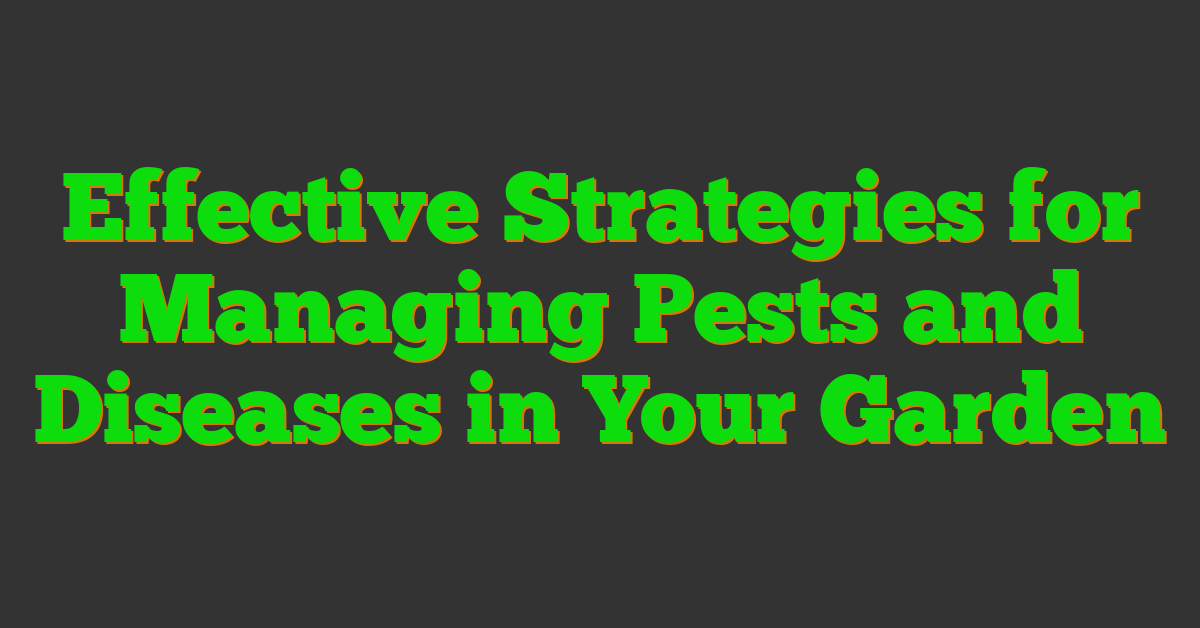Gardening should be a joyful escape, a place where you can relax and watch your plants thrive. But when pests and diseases sneak in, it can quickly turn into a frustrating battle. I’ve been there, feeling overwhelmed by unexpected invaders in my green sanctuary.

Over time, I discovered effective strategies to keep my garden healthy and vibrant. From natural remedies to proactive prevention, managing these challenges doesn’t have to be daunting. Let me share some tips that will help you protect your plants and enjoy a flourishing garden all season long.
Identifying Common Garden Pests
Keeping my garden thriving starts with identifying the pests that threaten my plants. Early detection allows me to address issues promptly.
Recognizing Pest Signs
I monitor my plants for signs like chewed leaves, sticky residues, and discoloration. Additionally, I check for the presence of insects or their larvae on stems and undersides of leaves.
Common Pest Types
- Aphids: Small, soft-bodied insects that gather on new growth and stems.
- Slugs and Snails: Mollusks that leave slime trails and feed on a variety of plants.
- Spider Mites: Tiny arachnids causing stippling and yellowing on leaves.
- Whiteflies: Winged insects that suck plant sap, weakening the plants.
- Caterpillars: Larvae that chew through leaves, often found on vegetables and ornamental plants.
Preventative Measures for Pest Control
Keeping my garden pest-free starts with proactive strategies. I focus on maintaining cleanliness and selecting the right plants to minimize pest issues.
Maintaining Garden Hygiene
I regularly remove weeds and plant debris to eliminate hiding spots for pests. Cleaning up fallen fruits and leaves prevents pests from breeding. Additionally, I ensure proper spacing between plants to enhance air circulation, reducing the risk of fungal diseases and infestations.
Selecting Resistant Plant Varieties
I choose plant varieties known for their resistance to common pests and diseases. For example, I plant pest-resistant tomatoes and disease-tolerant peppers to reduce vulnerability. Incorporating native plants also helps, as they are naturally adapted to the local environment and less attractive to pests.
Managing Plant Diseases
Managing plant diseases keeps my garden healthy and thriving. I rely on these strategies to prevent and treat common issues.
Identifying Disease Symptoms
I watch for specific signs that indicate a plant is diseased:
- Leaf Spots: Discolored or spotted areas on leaves, often with a yellow halo.
- Wilting: Plants droop despite adequate watering, signaling root or vascular issues.
- Mold Growth: Powdery or fuzzy substances on leaves, stems, or fruit surfaces.
- Stunted Growth: Reduced size and vigor, indicating nutrient or disease problems.
- Discoloration: Changes in leaf color, such as yellowing or browning, due to nutrient deficiencies or infections.
Organic Disease Treatments
- Neem Oil: Spraying neem oil disrupts fungal growth and repels insects.
- Copper-Based Sprays: Applying copper fungicides prevents and controls fungal infections.
- Companion Planting: Growing disease-resistant plants alongside susceptible ones reduces disease spread.
- Proper Air Circulation: Ensuring adequate spacing between plants decreases humidity and limits disease development.
- Crop Rotation: Changing plant locations each season disrupts pest and disease life cycles.
Integrated Pest Management Strategies
Combining various methods offers effective and sustainable pest control in your garden.
Biological Controls
I introduce natural predators like ladybugs and lacewings to reduce aphids and other pests. Using beneficial nematodes targets soil-dwelling insects without harming plants. Additionally, I apply microbial agents such as Bacillus thuringiensis to control caterpillars and larvae.
Chemical Control Options
When necessary, I choose selective pesticides like insecticidal soaps and neem oil to minimize impact on beneficial insects. I apply chemicals precisely to affected areas, following label instructions for safe and effective use. Monitoring pest levels helps me determine the right timing for chemical interventions.
Enhancing Garden Health
Maintaining garden health involves proactive steps to create a thriving environment for your plants. I focus on soil quality and attracting beneficial insects to keep pests in check.
Soil Improvement Techniques
Healthy soil is the foundation of a vibrant garden. I enrich soil by adding compost, which supplies essential nutrients and improves texture. Testing soil pH ensures plants receive the right conditions; most thrive in slightly acidic to neutral soil (pH 6-7). Incorporating organic matter like leaf mulch enhances moisture retention and drainage. Additionally, practicing crop rotation prevents nutrient depletion and reduces disease buildup, promoting long-term soil fertility.
Promoting Beneficial Insects
Encouraging beneficial insects helps naturally control pest populations. I attract ladybugs, which feast on aphids and other soft-bodied pests. Planting flowers like marigolds and sunflowers provides nectar for lacewings and hoverflies. Creating habitats with bee hotels and butterfly gardens supports pollinators and predators. Introducing predatory insects, such as praying mantises and spiders, balances the ecosystem. By fostering a diverse insect population, I reduce reliance on chemical pesticides and enhance overall garden resilience.
Conclusion
Gardening has its challenges but seeing my plants flourish makes it all worth it. By staying attentive and using the strategies I’ve shared, handling pests and diseases becomes much easier. I love experimenting with natural remedies and watching beneficial insects do their part. Every season brings new lessons and successes, and building a resilient garden is truly fulfilling. Here’s to a vibrant and healthy garden all year round!
















